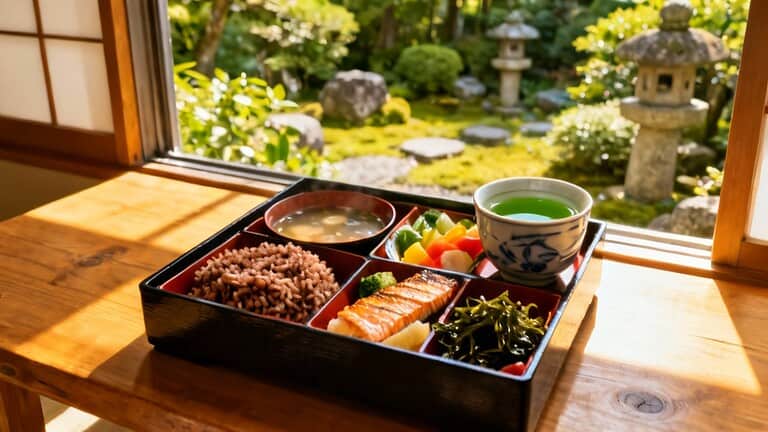What if you could live to 90 or even 100 without spending your final years in hospitals or relying on others to get through the day?
That’s not wishful thinking—it’s happening right now in Japan, where over 90,000 centenarians aren’t just alive, they’re thriving. They garden, cook, laugh, and walk unaided well into their golden years.
The secret isn’t expensive superfoods or rare herbs. It’s simple, everyday ingredients often overlooked in Western diets but backed by science and part of Japan’s daily routine.
In this article, we’ll explore seven powerful foods that play a crucial role in Japanese longevity and share one surprising daily habit that helps maintain balance and strength even in their 90s.
1. Japanese Brown Rice (Genmai)
While white rice dominates Western diets, Japanese seniors prefer genmai—brown rice that keeps its outer bran layer intact.
This simple swap delivers more fiber, B vitamins, magnesium, and selenium—nutrients critical for heart health, digestion, and blood sugar control.
According to the American Journal of Clinical Nutrition, people who eat more whole grains like brown rice have a 21% lower risk of cardiovascular disease and a 30% lower risk of type 2 diabetes. In Japan, older adults often start their day with a small bowl of genmai served with vegetables or seaweed.
Simple tip: If you’re used to white rice, start by mixing 50/50—half brown, half white. Your palate and digestion will adjust over time.
2. Miso Soup
Miso isn’t just a starter in Japan—it’s a daily ritual, especially among those over 80 and 90. This fermented paste made from soybeans and koji creates natural probiotics that support a healthy gut microbiome, your body’s first line of defense.
A study from the National Institutes of Health found that a diverse gut microbiome is strongly linked to lower rates of inflammation, dementia, and heart disease in older adults.
Miso soup is typically enjoyed for breakfast—a warm bowl with seaweed, tofu, and scallions that’s gentle on the stomach and deeply nourishing.
Easy preparation: Just dissolve a spoonful of miso in warm water (not boiling—high heat kills the probiotics), add soft tofu and greens, and enjoy.
3. Oily Fish (Mackerel, Sardines, Salmon)
Unlike the typical Western dinner where fish might appear once a week, older Japanese adults eat small portions of oily fish four to five times weekly.
These fish are rich in omega-3 fatty acids, proven to reduce inflammation, lower triglycerides, and protect against heart disease.
The American Heart Association reports omega-3s can reduce cardiac death by up to 10%. But the benefits extend beyond heart health—omega-3s are also linked to slower cognitive decline, helping protect memory and mood as we age.
Japanese preparation: Fish is prepared simply—grilled with ginger, steamed with veggies, or simmered in light broths without deep frying or heavy sauces.
4. Colorful Vegetables
Japanese meals often feature three to five small vegetable side dishes, each with different colors and textures.
Deep green spinach, bright orange carrots, purple eggplant, white daikon radish, and vibrant yellow squash create a nutritional rainbow on every plate. Each color represents different antioxidants and micronutrients your body needs to fight aging.
According to the Journal of Nutrition, higher vegetable variety is linked to lower risk of chronic disease and greater longevity, especially in adults over 60.
Practical approach: Focus on local seasonal vegetables and aim for three plus colors on your plate. Steam, sauté, or lightly pickle them to retain nutrients and flavor.
5. Seaweed (Wakame, Nori, Kombu)
Seaweed isn’t a trend in Japan—it’s a daily staple used in soups, salads, broths, or eaten as snacks. Just small amounts deliver massive nutritional value, including iodine for thyroid function, calcium, magnesium, potassium, and soluble fiber that feeds the gut microbiome.
Studies published in Marine Drugs link regular seaweed consumption to lower cholesterol, reduced inflammation, and decreased cancer risk in aging populations.
Easy incorporation: Add dried wakame to miso soup or keep roasted nori as a healthy snack. Kombu, used in dashi broth, enhances flavor with natural umami while delivering trace minerals.
6. Soy Foods (Tofu, Edamame, Natto)
Soy shows up in nearly every Japanese meal, contributing to Japan’s low rates of heart disease and osteoporosis.
Soy is a plant-based protein powerhouse, low in saturated fat and high in calcium, iron, and isoflavones—compounds shown to reduce cholesterol and support bone density after age 50.
Harvard research indicates replacing red meat with soy-based protein may lower heart disease risk by 20% or more.
The Japanese enjoy tofu in soups, grilled with soy sauce, or cold with scallions. Natto, though pungent, is packed with vitamin K2 and nattokinase for blood circulation.
7. Green Tea
Green tea is more than a drink in Japan—it’s a daily wellness ritual. Rich in catechins, powerful antioxidants that fight cell damage and reduce inflammation, green tea offers impressive benefits for brain function and heart health.
A long-term study from Tohoku University found Japanese adults who drank green tea daily had a 76% lower risk of functional disability in old age.
The two most common types are sencha (everyday tea) and matcha (powdered form with up to 10 times more antioxidants).
Brewing tip: Use warm water, not boiling—about 60-80°C (140-175°F) to preserve nutrients and avoid bitterness.
The Bonus Secret: Daily Movement Habits
Beyond food, Japanese seniors stay agile through gentle, functional movements integrated into daily life:
- Shikodachi: A wide, grounded martial arts stance practiced 2-3 minutes daily to build leg strength and balance
- Seiza: Traditional kneeling posture that improves hip flexibility and posture
- Wall squat: Holding your back against a wall in a squat position for 30 seconds daily to boost knee and lower back strength
These simple movements require no equipment but deliver significant benefits for mobility, circulation, and confidence over time.
Your Journey Starts Today
You don’t need to move to Japan to benefit from these longevity secrets. Start with one small change—swap white rice for brown, add a cup of green tea to your afternoon, or try a wall squat before bed.
Your journey toward healthy aging begins with that first step toward incorporating these simple, powerful habits into your daily routine.








